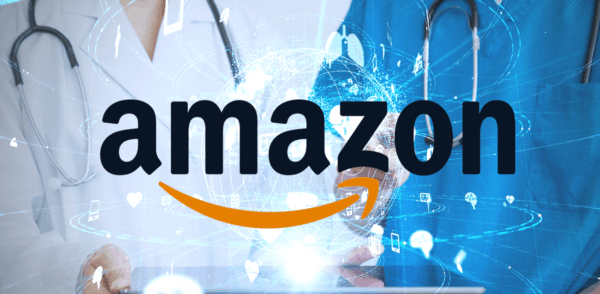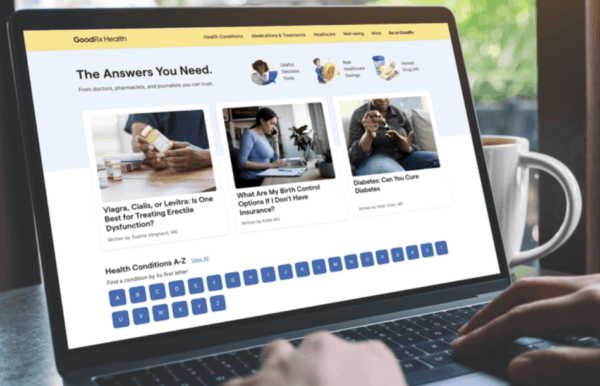|
AWS Accelerator Finalists | GoodRx Health
October 3, 2021
|
|
|

|
|
Together with
|

|
|
|
“I was shocked by the performance gap between the healthcare providers fully embracing a content strategy around health information, and those who are either taking half-measures or failing to pursue this strategy altogether.”
|
|
Boston Digital Director of Strategy, Philip Chevalier
|
|

|
|
Amazon Announces Healthcare Accelerator Finalists
Digital health startups were in the spotlight this week as Amazon announced the ten finalists for its first ever AWS Healthcare Accelerator.
The companies were selected from 427 applications and 31 countries around the world, although each finalist is US-based. The finalists were chosen by a panel from Amazon Web Services (AWS) and KidsX, an accelerator for companies focusing on pediatric care. Each startup has a validated solution along with existing revenue and customers.
The AWS Healthcare Accelerator is a four week program that pairs finalists with technical and business mentorship from experts from AWS and KidsX, then offers collaboration opportunities with members of the AWS Partner Network looking for healthcare solutions.
AWS Healthcare Accelerator finalists include:
- AIVA is a voice-powered care assistant for hospital patient rooms and senior living communities with a mission to be the voice operating system for better care.
- b.well offers an integrated solution for consumer engagement, holistic health management, and cost containment. They use longitudinal aggregated data to paint a picture of health for each consumer and aggregate data to show population health.
- Ejenta automates remote monitoring and remote care delivery using AI exclusively licensed from NASA. Their “intelligent agents” learn from connected devices and EHR data to monitor patients, predict health, and connect care teams.
- Giblib creates an educational content streaming experience for healthcare providers. It allows for on demand streaming of surgical videos and medical lectures from subject matter experts along with the ability to receive continuing education credits.
- Gyant is a virtual assistant and digital front door solution designed to optimize patient journeys. It navigates patients to the right care setting and resources while providing simple appointment scheduling.
- Kaizen Health is a healthcare logistics platform that connects healthcare and transportation to reduce access barriers.
- Medical Informatics Corp offers an FDA-cleared Sickbay virtual care platform that helps hospitals improve operational efficiencies by enabling the rapid scaling of remote patient monitoring across any inpatient setting.
- Neuro Rehab VR is reinventing training exercises for physical and cognitive therapy by leveraging VR and neuroplasticity for recovery. It allows providers to track their patients in real time and has shown increased patient engagement.
- OneRecord provides an app that helps patients build a consolidated health record of their entire medical history in a single place.
- Pieces uses AI to connect patients and health systems with solutions that address social determinants of health. They connect care providers to actionable data, people to services, and caseworkers to information.
Industry Impact
Amazon’s multi-pronged strategy for entering the healthcare market goes beyond its hands-on approach with Amazon Care. By providing companies such as these finalists with AWS solutions, Amazon is establishing itself as the cloud-based foundation for a new cohort of healthcare disruptors.
|




|
|

|
|
Digital pharmacy tool GoodRx recently launched an expansive online resource called GoodRx Health to provide research-based answers to popular health questions.
GoodRx Health takes a different approach than other consumer health destinations, offering actionable insights through GoodRx Answers and a Health Wizard for navigating difficult decisions.
- GoodRx’s current services include app-based prescription tracking and a telehealth platform called GoodRx Care, which provides virtual primary care services.
- GoodRx Help adds new ways for users to explore the company’s library of Video Explainers and editorial content, a large strategy shift that pushes the company beyond its current role as a comparison tool.
- GoodRx’s new strategy targets every stage of a consumer’s healthcare journey, uniting the company’s platforms by directing diagnosis-seeking consumers from GoodRx Health to its GoodRx Care telehealth service for treatment.
The Takeaway
GoodRx Health is far from a small content play to drive more traffic to a website. GoodRx is doing everything in its power to leverage the 20m monthly users already visiting its site, from hiring a 50 person editorial team helmed by the former executive editor of WIRED, Thomas Goetz, to acquiring health video company HealthiNation for $75m in April.
WebMD and symplr announced a similar partnership in August, which allows WebMD users to go from a health information search to scheduling a telehealth appointment in three clicks. GoodRx’s vertical integration of these services could position it as a leader among companies operating in the overlap between health information and treatment.
|




|
|
Nuance’s Patient Engagement Must-Haves
Consumer demands are shifting, and they’re looking to get more out of their digital health technology. Nuance outlines the 5 must-haves for your patient engagement strategy here.
|
|
- Website Traffic Drivers: There’s no such thing as too much good information, at least according to a Boston Digital report of the top 20 US hospitals. The report found that hospital websites with large digital health libraries often see 100x more traffic than those without. The three highest ranked hospitals (Mayo, Hopkins, Cleveland) offer comprehensive and original content that lives on their top-level domains, while lower ranked systems didn’t meet these criteria. Mayo Clinic has 15k pages of health information content and generates the most traffic, while hospitals with fewer than 3k pages earn less than 10% of its total visitors.
- Early Flu Detection: Duke researchers recently found that wearables might be able to identify the flu and common cold prior to the onset of any symptoms. The study included 31 participants with H1N1 and 18 with rhinovirus (common cold). The researchers were able to distinguish between mild and moderate infection 24 hours prior to symptom onset with 90% accuracy for H1N1 and 89% for rhinovirus. The smartwatches used in the study were from a specialized manufacturer, so it might still be a while before your Apple Watch lets you know when you’re catching a cold.
- Funding Empathy: End-of-life assistance provider Empathy recently raised a $30m Series A round ($43m total funding) within six months of exiting stealth mode. The company’s platform combines technology and human support to provide a “digital companion” to bereaved families, helping them through end-of-life tasks such as arranging a funeral and canceling accounts. Empathy aims to use technology to empower families handling all the responsibilities and emotions that come with loss.
- Platform Sprawl: A new hospital survey from Amwell and HIMSS Analytics found that most clinicians are using at least three platforms for virtual care, and that 20% of academic medical centers are using eight or more digital care platforms for telehealth. This “platform sprawl” is creating a disjointed user experience, causing 25% of clinicians to report that their current workflows are not integrated with their organizations’ existing systems. This issue is not lost on health system leaders, with 77% saying that it is important to move to a single integrated virtual care platform.
- Walmart’s Epic Partnership: Walmart announced a partnership with Epic to integrate its EHR system across all in-person and virtual health services. Epic’s EHR system will be deployed in four Walmart Health centers in Florida early next year before expanding throughout the business. This is the latest in a series of moves to advance Walmart’s healthcare strategy, which have included a deal with value-based primary care startup Oak Street Health to open clinics at Walmart supercenters, as well as the acquisition of specialty telehealth provider MeMD.
- The Value of an Extra Year: A recent paper published in Nature investigated the monetary implications of curbing aging, finding that the average American would pay $242k for one extra year of good health. Researchers calculated that an intervention that slows biological aging (lowering both mortality and frailty) while increasing life expectancy by one year would create approximately $38t in value (more than 3% of US GDP). The calculations focus on quantity of life as well as quality of life, underscoring the need to shift attention from the pursuit of a longer lifespan (just time) to healthspan (years spent in good health).
- Virtual First Care Toolkit: The IMPACT virtual first care (V1C) initiative co-hosted by the Digital Medicine Society and American Telemedicine Association recently launched a Payer-V1C Contracting Toolkit that provides a guide for contracting with V1C solutions. According to IMPACT, existing payer processes have not been keeping pace with V1C innovations, and new solutions do not fit into traditional contracting structures. The Toolkit aims to close this gap in order to expand V1C adoption beyond direct-to-patient models.
- Telehealth Satisfaction Declines: A new JD Power 2021 US Telehealth Satisfaction Study of 4.7k consumers found that telehealth usage climbed from 9% in 2020 to 26% in July 2021, although overall satisfaction ratings fell 8.5% as a result. Respondents reported telehealth complaints related to limited services (24%), confusing technology (15%), and lack of information about care providers (15%). Many providers began offering telehealth during the pandemic without proper success guidelines, and JD Power recommends focusing on convenience, speed, and safety to drive patient satisfaction.
- Alphabet Tag Team: Verily’s chronic condition management division Onduo is partnering with Fitbit to provide wearables to users in an effort to promote whole person health and wellness. Both companies are Alphabet-owned subsidiaries, highlighting the benefits achieved by the organization’s scale. Offering Fitbits alongside Onduo’s multi-condition platform (diabetes, hypertension, mental health) gives members a more comprehensive view of how factors like sleep and stress fit together, helping participants better manage their health and build effective routines.
- Private Coverage Declines: The latest US Census data shows that private health coverage declined 0.8% to 71.8% for adults ages 19 to 64 between early 2019 to early 2021, reflecting lower coverage rates following the beginning of the pandemic. Although employment-based coverage saw a 0.6% drop to 61.6%, this decline was offset by a 0.6% increase in public coverage through programs such as Medicaid. This exchange saw the percentage of working age adults without health coverage remain stable at ~12.5% during the time period.
|
|
|
|
|